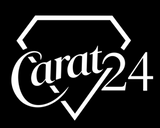So, you've got a piece of jewelry and the big question is... is it the real deal? Learning how to tell real gold from fake is a skill every collector and seller should have. Before you get into the more scientific tests, a simple, careful look can tell you a surprising amount.
Your eyes are your first and best tool. Genuine gold just feels different. It has a unique, warm luster and a satisfying heft that fakes can rarely pull off.
Your First Look Identifying Real Gold
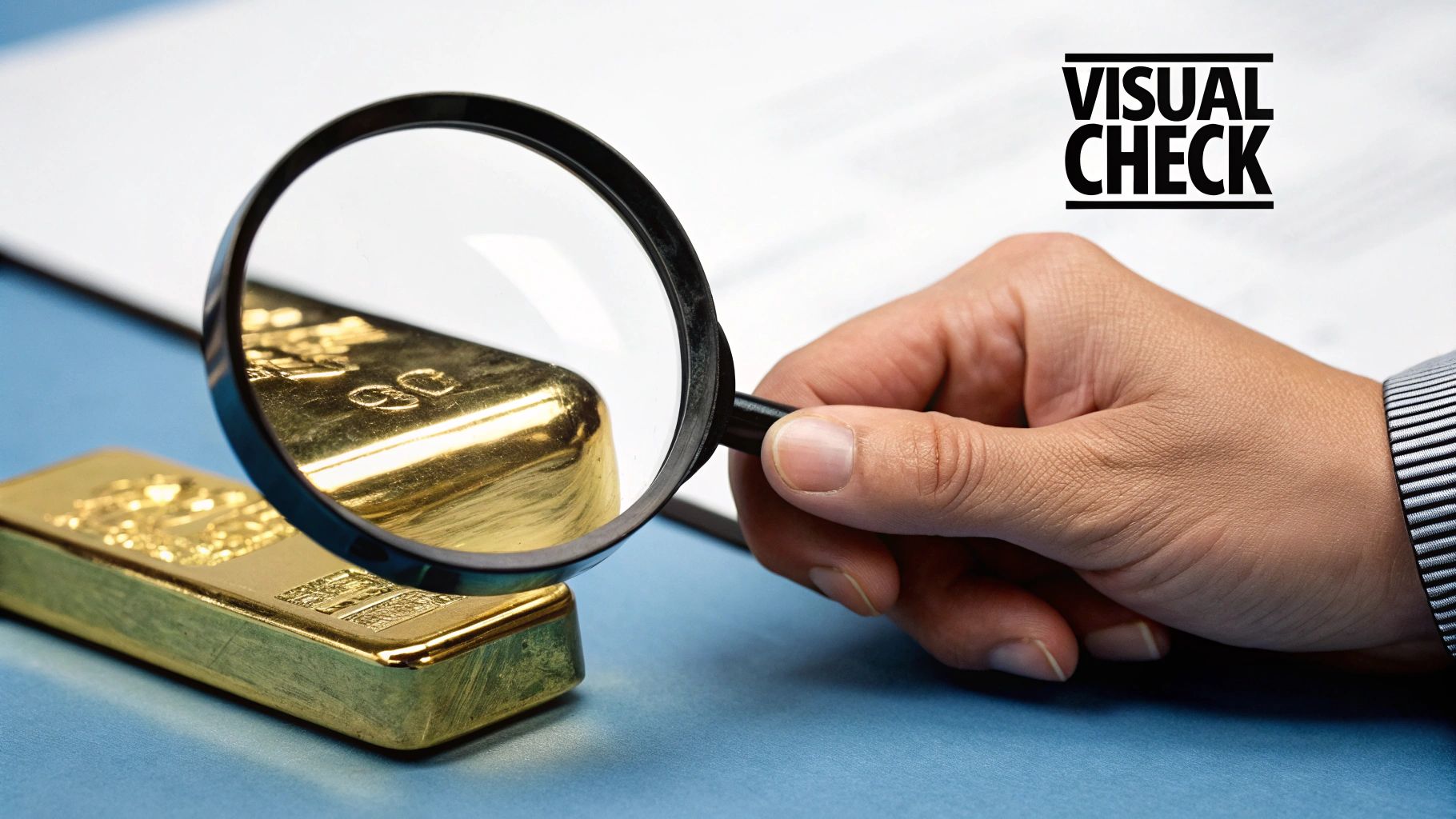
Think of this initial once-over as your first line of defense. It's perfect for when you're browsing a flea market or sorting through a box of inherited pieces. Real gold is dense, so it has a tangible weightiness to it. If you pick something up and it feels surprisingly light for its size, that’s an immediate red flag.
Counterfeit items are often made from cheaper, less dense metals. They just don't have that solid, substantial feel you expect from gold. This is especially obvious with pieces that claim to be high-karat. A big, chunky chain marked "22K" that feels like it weighs next to nothing is almost certainly not what it claims to be.
The color is another dead giveaway. Solid gold has a rich, consistent tone all the way through. Plated pieces, on the other hand, often show their true colors—literally—on the edges or high-wear spots, revealing a different, duller metal underneath.
Key Visual and Physical Clues
When you first get your hands on a piece, slow down and pay attention to the details. These clues can help you quickly sort the promising items from the definite fakes.
- Weight and Density: Gold is one of the densest precious metals. A genuine gold chain will feel noticeably heavier than a chain of the exact same size made from something like copper or brass.
- Color Consistency: Check the piece all over, but pay special attention to the clasp, ring band, and edges. If you see any chipping or spots where a different color is peeking through, it's a clear sign of plating wearing off.
- Signs of Tarnish or Rust: Here's a simple fact: gold doesn't rust or tarnish. While some lower-karat gold alloys might show a bit of discoloration after decades of wear, any significant green or black marks are a big warning sign that you're not dealing with solid gold.
To give you a clearer picture, here's a quick cheat sheet for what to look for.
Real vs Fake Gold At a Glance
| Characteristic | Real Gold | Fake Gold (Plated or Alloy) |
|---|---|---|
| Feel | Heavy and dense for its size. | Feels light or "hollow." |
| Color | Consistent, warm, rich tone throughout. | May have spots of discoloration or show a different base metal at wear points. |
| Reaction | Does not tarnish, rust, or turn your skin green. | Can tarnish, rust, or leave green/black marks on skin. |
| Luster | Soft, warm, and distinctive shine. | Can be overly shiny, almost brassy, or unnaturally yellow. |
This table should help you spot the most obvious signs right away, but keep in mind that sophisticated fakes are out there.
The only way to be 100% sure is to have a professional take a look. If you're here in Boise, you can skip the guesswork and the hassle of shipping your valuables. You can save the hassle and sell locally for more than online shipments.
At the end of the day, these visual checks are a great starting point, but they aren't foolproof. To see what authenticated, high-quality pieces look like, you can browse our collection of gold. For absolute certainty and to ensure you get the highest payout for your items, nothing beats professional testing, like a free X-ray scan that can confirm the exact metal composition in seconds.
Simple At-Home Tests for Gold Authentication
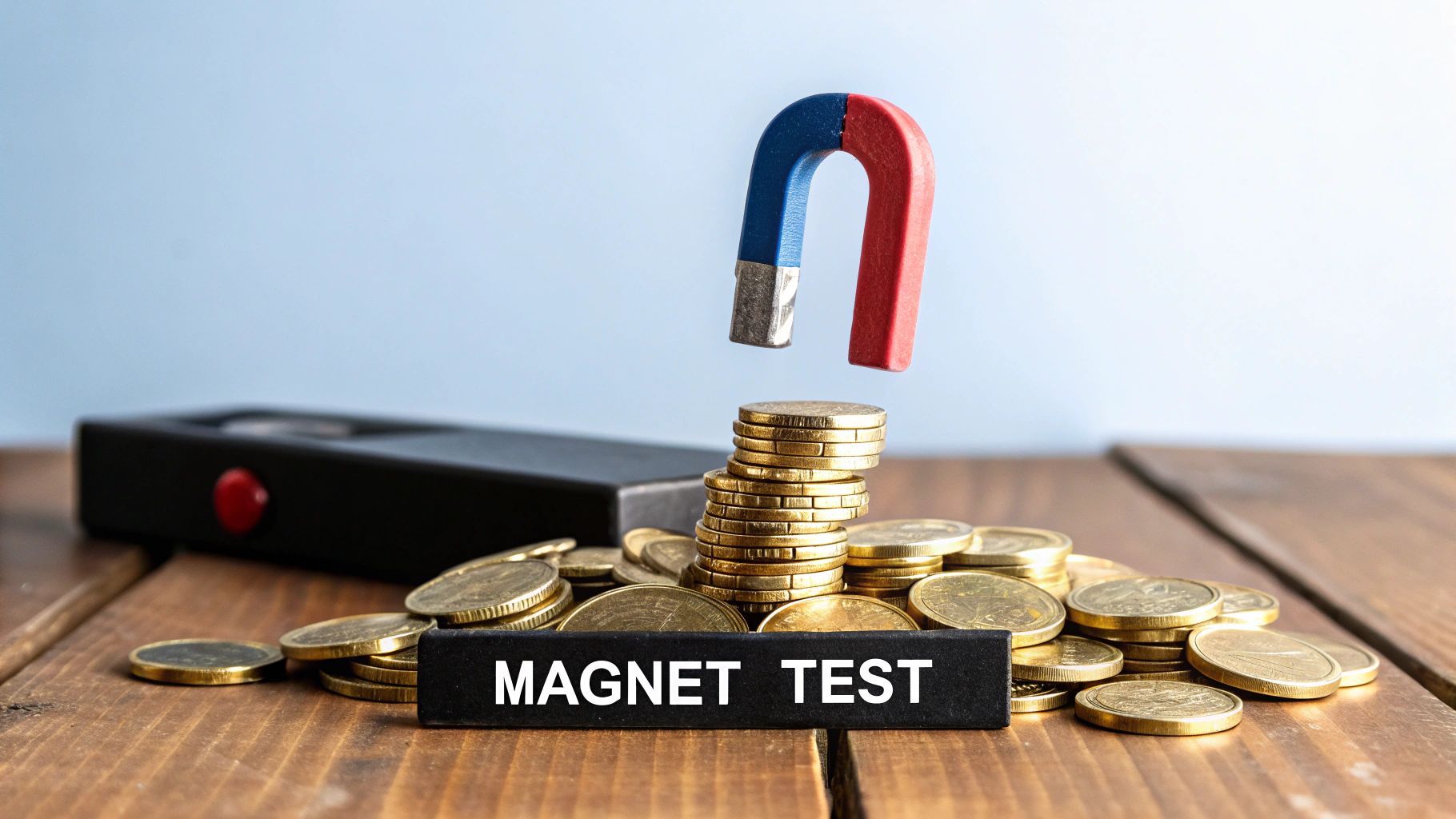
Once you’ve given your piece a good look-over, it’s time to get a little more hands-on. You can actually run some surprisingly effective tests with items you likely have around the house. These quick checks are a great next step in learning how to tell real gold from fake and can often weed out the most common counterfeits without costing you a thing.
One of the first things I always try is the magnet test. It’s incredibly simple, completely safe for your jewelry, and can give you an answer in seconds.
The Reliable Magnet Test
Here’s the science in a nutshell: real gold is a non-ferrous metal, which means it’s not magnetic. So, if you take a strong magnet—something more powerful than a flimsy fridge magnet—and hold it right up to your piece, nothing should happen. If the jewelry snaps right to the magnet, that’s a dead giveaway.
That magnetic pull means there's iron or another magnetic metal hiding under a thin gold plating. It's a classic trick used in cheap fakes, and this test exposes it immediately.
Of course, there are a couple of nuances to keep in mind:
- The Clasp Exception: A lot of real gold chains and bracelets use a tiny steel spring inside the clasp for durability. That little spring is magnetic. So, make sure you test the links of the chain or the main body of the piece, not just the clasp.
- Non-Magnetic Fakes: Craftier counterfeiters sometimes use non-magnetic base metals like brass or copper. This means the magnet test isn't the final word. It's fantastic for catching low-quality fakes, but you'll want to pair it with other methods to be sure.
The Skin Discoloration Test
This one is as simple as it gets and uses your own body chemistry. You know that unsightly green or black ring you get on your finger from wearing cheap costume jewelry? That's exactly what you’re looking for here—or rather, what you don't want to see.
Just hold the piece of gold firmly in your palm for a few minutes. If your hands are a little clammy, even better. The salt and moisture on your skin will speed up any potential chemical reaction.
Real gold will never tarnish or leave a colored mark on your skin. If you pull your hand away and see any green, black, or even bluish stains, you're almost certainly dealing with an item made of copper, nickel, or some other alloy—not solid gold.
The beauty of this test is its simplicity. If your skin stays clean, it's a very good sign that you're holding the real deal.
While these at-home tests are great for initial checks, they can’t tell you the exact karat purity or true value of your gold. For that, you really need the eye of a professional. Instead of guessing, our Gold and Jewelry Buying experts can give you hassle free offers backed by professional, free Gold Testing and Xray Scanning. You can save the hassle and sell locally for more than online shipments right here in Boise, knowing you’re getting the highest payout in Boise. We even offer Price Matching to guarantee you're getting the best possible deal.
Decoding Hallmarks and Official Markings
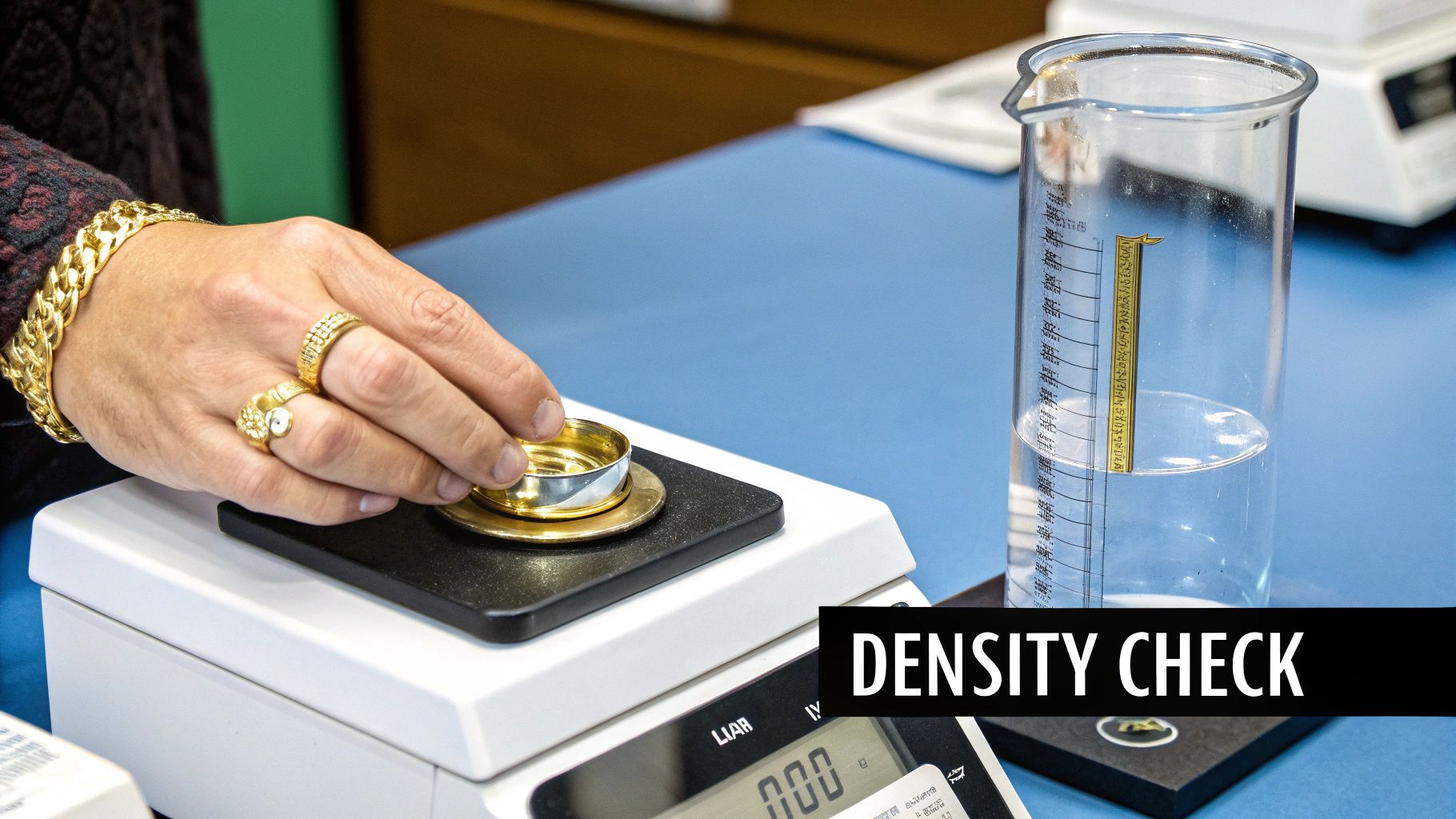
While the physical tests are great hands-on methods, sometimes the most important clues are stamped right onto the gold itself. These tiny engravings are called hallmarks, and they essentially act as a passport for your jewelry, telling you about its purity and where it came from. Learning to read them is one of the most important skills you can develop.
You’ll usually find the hallmark tucked away somewhere discreet—think the inside of a ring’s band or the tiny clasp on a necklace. You'll probably need a good magnifying glass to see it clearly, but it's well worth the effort for an instant snapshot of the piece's claimed quality.
Karats vs. Fineness Marks
Here in the United States, we're most familiar with the karat system. A stamp like "14K" or "18K" is telling you the gold content out of 24 parts. For example, 14K means the piece is 14 parts gold and 10 parts other metals. Simple enough.
But if you have jewelry from Europe or other parts of the world, you’ll likely see a fineness number instead. This system just measures gold purity in parts per thousand. It's just as easy to understand once you know the numbers:
- 10K Gold is often stamped with "417," meaning it's 41.7% pure gold.
- 14K Gold corresponds to a "585" stamp (58.5% gold).
- 18K Gold will be marked "750" (75% gold).
- 24K Gold, which is pure gold, is marked "999."
Spotting a "750" mark on a piece is a fantastic sign, especially if it has that distinct European look. If you're curious about a specific style, you can learn more in our guide on what makes Italian gold so special.
Watch Out for Fake Stamps and Plating Marks
Here’s the catch: a stamp alone isn't a 100% guarantee. Forgeries exist. However, counterfeiters often get lazy or use specific markings that give the game away. You need to be on high alert for stamps like:
- GP (Gold Plated)
- HGE (Heavy Gold Electroplate)
- GF (Gold Filled)
If you see any of these abbreviations, you know you aren't holding solid gold. These pieces have a thin layer of real gold on the outside, but their core is just a cheap base metal.
The accuracy of a hallmark is paramount, but even professional testing tools can have their limits. A study on handheld gold testers revealed that while 14k gold results were consistently reliable, readings for lower karats could be off by a full karat or more, requiring multiple tests to confirm. You can discover more insights about gold testing methods from the GIA.
This is exactly why you can't rely only on what you see, even with a magnifying glass. For a guaranteed assessment, nothing beats professional Gold and Jewelry Buying services. Here in Boise, you can get free Xray Scanning and Gold Testing to verify your items instantly. It’s the only way to ensure you get hassle free offers and the highest payout in Boise, backed by our Price Matching guarantee. You can save the hassle and sell locally for more than online shipments.
So, the simple tests didn't give you a clear answer? When you're still not 100% sure, it’s time to move on to some of the more advanced methods you can try at home.
These next steps require a little more gear and attention to detail, but they can give you a much more definitive verdict on whether you’re holding real gold or a clever fake. We're moving past simple observation and into the world of chemistry and physics.
The Classic Acid Test
One of the oldest tricks in the book is the nitric acid test. It’s been a go-to for jewelers and pawnshops for generations for a reason—it works. You’ll need a gold testing kit, which comes with small bottles of nitric acid formulated for different karat weights (10K, 14K, 18K, etc.).
The idea is to make a very small, subtle scratch on the item, somewhere it won't be noticed. Then, you apply a single drop of acid that matches the karat you think the piece is.
If the gold is real and matches the karat, nothing will happen. The acid won't react. But if it's a fake or a lower karat than you're testing for, you'll see a reaction almost immediately. A green color points to a base metal like copper, while a milky reaction often means you're looking at gold-plated sterling silver.
A quick word of warning: Safety is paramount here; always wear gloves and eye protection and work in a well-ventilated area. You’re working with acid, after all.
The infographic below breaks down the simple "reaction vs. no reaction" outcome.
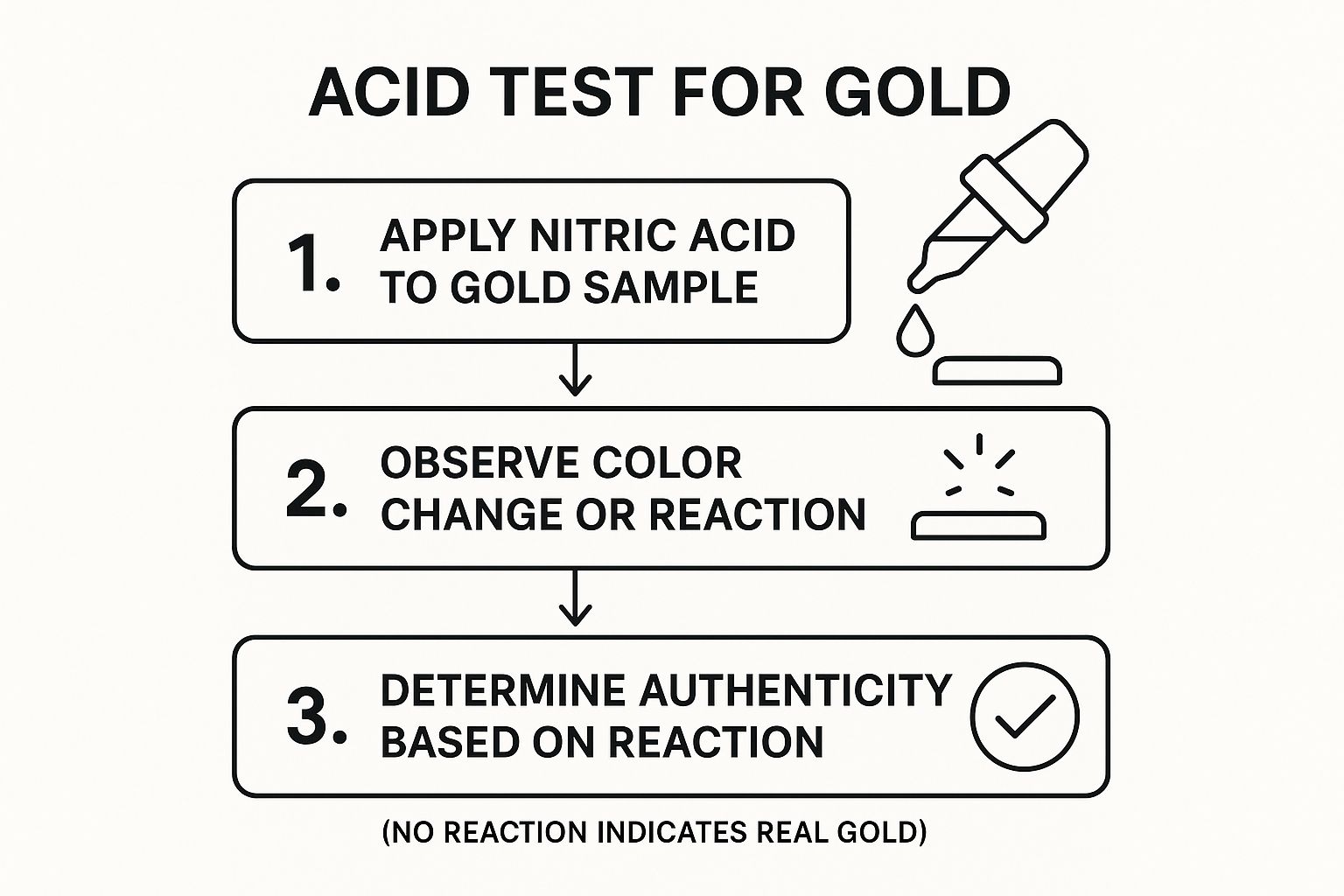
As you can see, the key is simply watching what the acid does. That reaction (or lack thereof) tells you everything you need to know about its authenticity at that specific karat level.
Using Density to Uncover the Truth
Another powerful method relies on one of gold’s most famous properties: its incredible density. This test uses Archimedes' principle to see if your item has the right heft to be genuine gold. You’ll need a good digital scale (one that measures to at least a tenth of a gram) and a small cup of water.
Here’s how it’s done:
- First, weigh the item completely dry and write down the number.
- Next, place your cup of water on the scale and hit the "tare" or "zero" button.
- Completely submerge the item in the water without it touching the bottom or sides. A thin piece of thread works great for this. The weight that now shows on the scale is the volume of water displaced.
- Finally, divide the dry weight by the submerged weight. That's your density.
Pure, 24K gold has a density of about 19.3 g/cm³. Other karats will have slightly different densities, but they'll all be in the same ballpark.
This method isn’t foolproof, though. It’s estimated that around 20% of gold items brought into pawnshops are fakes, and some forgeries are getting incredibly sophisticated. Counterfeiters have started using tungsten cores plated in real gold because tungsten’s density (19.25 g/cm³) is almost identical to gold's. A simple water test just can't spot that difference.
While these at-home tests are great, they have their downsides. Acid can permanently damage a piece if you're not careful, and density tests can be tricked by high-quality fakes. For a 100% guaranteed answer, nothing beats a professional analysis.
Here in Boise, we provide free Gold Testing and Xray Scanning. It's non-destructive, takes just a few seconds, and gives you a definitive answer. You’ll get hassle free offers knowing you're receiving the highest payout in Boise, backed by our Price Matching policy.
And if you’re curious about the purity of specific items, you might find our article on the gold content in Mexican coins an interesting read.
When It's Time to Call in the Pros
While the DIY tests we've covered are great for a first pass, think of them as preliminary screening. They give you clues and a solid indication, but they aren't foolproof.
When you're dealing with something potentially valuable—an heirloom from grandma, a chunky chain you found at an estate sale, or anything you're thinking of selling—it's time to move past educated guesses. Professional verification is the only way to get a definitive, bankable answer.
The Power of Professional Gold Testing
When you bring a piece to an expert, they're not just going to hold a magnet to it. They have access to some seriously impressive technology that gives a precise, non-destructive reading of exactly what your item is made of. The star of the show here is the X-Ray Fluorescence (XRF) scanner.
An XRF scanner is a high-tech device that bombards the metal with a safe level of X-rays. This causes the atoms inside to fluoresce, or glow, in a way that’s unique to each element. The machine reads these unique energy signatures and spits out a detailed report of every single element in the alloy—gold, silver, copper, nickel, you name it—down to the exact percentage.
The whole process is:
- Completely Safe for Your Jewelry: Unlike acid tests which can leave a permanent mark, XRF scanning is 100% non-destructive. Your piece will be returned in the exact same condition.
- Incredibly Fast: We're talking seconds, not minutes. You get a full analysis almost instantly.
- Extremely Accurate: This isn't an estimate. It's a precise elemental breakdown, confirming the exact karat purity.
For centuries, the "gold standard" for testing was the fire assay method, a process that involved literally melting down a sample to separate the metals. It's incredibly accurate, but obviously not something you want to do to a finished piece of jewelry. The XRF scanner gives us that same level of certainty without harming a thing, which is why it has become the trusted modern solution for the global jewelry industry.
Why Selling Locally in Boise Is a Smarter Move
If you're in the Boise area and looking to sell, coming to a local expert is your best bet. Forget the hassle and risk of those mail-in programs.
When you choose to sell your gold locally, you get to be part of the process. You can watch the testing happen right in front of you, ask any questions you have, and get a transparent, immediate offer. There's no stress of shipping your valuables and just hoping you get a fair assessment from a company miles away.
Here at Carat 24, we offer Xray Scanning and Gold Testing for free through our expert Gold and Jewelry Buying services. Our whole approach is to give you hassle free offers backed by precise, verifiable data. This ensures you get the highest payout in Boise for your gold and silver.
We're so confident we offer the best prices that we have a Price Matching guarantee. If you're curious about how valuations work in general, our guide on how to get a jewelry appraisal near you is a great resource to check out.
Ultimately, getting a professional verification isn't just about finding out if your gold is real. It’s about peace of mind and financial security, making sure you know exactly what you have and are paid fairly for its true worth.
Still Have Questions About Identifying Gold?
After running through visual checks and maybe even trying a few at-home tests, it's completely normal to have some lingering questions. Sorting out what's real from what's not often comes down to understanding the finer details, and we hear these common queries all the time. Let's tackle them head-on so you can feel confident in your assessment.
Can Real Gold Actually Stick to a Magnet?
Nope. Real gold is a non-ferrous metal, meaning it isn't magnetic. An authentic gold piece won't react to a strong magnet at all. This is a great first-pass test because many fakes are made with iron-based metals that will snap right to a magnet.
But here’s a pro tip: be careful with the clasp. Many genuine gold necklaces and bracelets use a tiny steel spring inside the clasp for durability, and that little spring is magnetic. To avoid a false reading, always test the main body of the jewelry—the chain links, the pendant, or the band of the ring—not just the clasp.
Does Real Gold Tarnish or Rust?
Pure, 24K gold is one of the least reactive metals on Earth. It absolutely will not tarnish or rust, which is why ancient gold artifacts can be pulled from the ground looking as brilliant as the day they were made.
However, most jewelry isn't pure gold. It's an alloy, like 10K, 14K, or 18K gold, mixed with other metals (like copper or silver) to make it stronger and achieve different colors. Over many years, these other metals can sometimes react to skin oils or environmental factors, causing a very slight discoloration. But if you see significant tarnish, green or black marks, or any hint of rust, that’s a massive red flag. The item is almost certainly fake or, at best, very thinly plated.
While these DIY tests are great for weeding out obvious fakes, they can't tell you the true value of your gold. Professional evaluation is the only way to get an accurate number. To see how purity dramatically impacts price, check out our guide on what your gold is worth.
What's the Most Reliable Gold Test I Can Do at Home?
Honestly, no single at-home test is 100% foolproof. That's why we always recommend using a combination of methods to build a more complete picture. Each test has its own pros and cons.
- The Density Test: This method is surprisingly accurate if you do it with precision. The catch? Sophisticated fakes sometimes use tungsten cores, which have a density almost identical to gold, making them very hard to spot this way.
- The Nitric Acid Test: For determining the actual karat, this is one of the most reliable tests. The downside is that it involves handling corrosive chemicals and requires you to scratch your item, causing minor but permanent damage.
- A Combined Approach: Your safest and most effective strategy is to layer the tests. Start with a thorough inspection for hallmarks, then use the magnet test, and finish with a close visual check for wear or discoloration. This simple sequence will catch the vast majority of common fakes without any risk to your jewelry.
Should I Sell My Gold Locally in Boise or Try an Online Buyer?
For most people, selling to a trusted local buyer right here in Boise is the smartest move. When you work with us through our Gold and Jewelry Buying service, you get the peace of mind that comes with a face-to-face transaction, hassle free offers, and immediate payment. No waiting, no risks.
Reputable local jewelers offer Gold Testing and Xray Scanning for free, using advanced equipment that online buyers simply can't match from a distance. This technology guarantees you get the highest payout in Boise.
Choosing local means you save the hassle and avoid the anxiety of shipping your valuables and hoping they don't get lost or undervalued. We even offer Price Matching, so you can be sure you'll sell locally for more than online shipments.
Ready to skip the guesswork and find out the true value of your gold and silver? Here at Carat 24, we use state-of-the-art technology to provide free, on-the-spot evaluations. Stop by our Boise location for a transparent, no-obligation offer and see what it's like to work with experts you can trust. Find out more at Carat 24.
